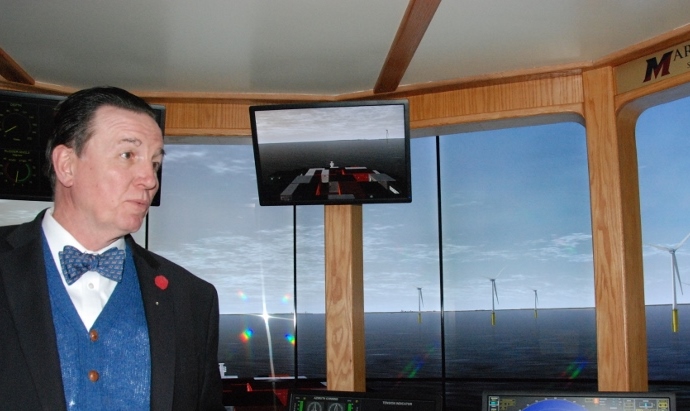With a few computer commands, a new future takes shape in the approaches to New York Harbor.
Already well known for its role in training tugboat and city ferry captains, the two-year-old Bouchard bridge simulator at SUNY Maritime College in Throggs Neck, N.Y., has a new program that shows workboat operators what they can expect working in and around offshore wind turbine arrays.
Both New York and New Jersey have big ambitions for wind energy, up to 1.9 gigawatts from projects now in the pipeline for the 2020s — roughly equivalent to three onshore nuclear power plants, like New Jersey’s aging Oyster Creek station.
Ultimately there could be twice as much energy coming from offshore wind farms, according to the governors of both states. A new report from the group Environment New Jersey notes 13 wind developers have obtained East Coast federal leases so far, with the potential of generating up to 14.2 GW, or enough to power over five million homes.
One of the first could be Statoil, with its 79,350-acre Empire Wind project, planned to tuck in between two of the traffic separation scheme lanes that converge near Ambrose Light. The waters off New York are attractive for wind developers because they are close to load centers, and politically there is support there for renewable energy — not least because the new industry will be out of sight from most of its customers.

The Kongsberg wind farm simulator program includes a scene with a turbine service vessel working in the array outside New York Harbor. Kirk Moore photo.
Of course, that would leave mariners and fishermen to deal with their new neighbor. In the simulator, new software from Kongsberg Digital Simulation Inc., Groton, Conn., projects images on the bridge windows of slowly twirling turbines, the Verrazano Narrows bridge in the far distance, and an assortment of traffic and weather.
In one scenario, an 18,000-TEU containership — modeled after the new generation of neo-Panamax box carriers that will be calling at East Coast ports — makes its ponderous way past the turbines.
In another version of the program, tugboat operators can practice for the possibility of an articulated tug-barge (ATB) suddenly experiencing a pin failure, and needing to execute a quick move to a wire tow.
“What about that wind farm? Better get that barge,” called out Eric Johansson, a SUNY professor of marine transportation, as a visitor made another attempt to reset the coupling on a wayward barge, the turbines looming closer.
Kongsberg is working to make these new wind turbine simulations ever more realistic, with modeling jackup installation vessels and crew transfer vessels that will carry construction and operations and maintenance workers to the high-tech windmills.
Developers are adding features to simulate the physics of docking CTVs, so operators in the simulator can get a feel for pressing the bows of boats hard against tower bases as workers hop off, said Clayton Burry, Kongsberg’s vice president for Americas sales. They are working on models of the new “walk to work” (W2W) transfer vessel designs, as large as offshore service vessels, with elevated, enclosed and stabilized gangways for workers to get in and out of towers.
By the time U.S. developers are ready to build, those may be the new standard for servicing turbines in the 9- to 12-megawatt sizes that are now emerging in the maturing European market.

A chart on the simulator deck shows the location of the proposed Statoil wind array off New York. Kirk Moore photo.
The federal Bureau of Offshore Energy Management, in consultation with the Coast Guard, has to decide on the required navigational safety requirements and setbacks from shipping lanes that it will require from wind lease developers.
A March 2016 report from Coast Guard officials and maritime advisors sounded a skeptical note over whether wind farms and shipping lanes can safely co-exist. Renewable energy advocates challenged that assertion, pointing to European experience with operating wind power amid the continent’s busy seaways.
Direct engagement with the U.S. maritime industry is starting now, and the Coast Guard will soon put out a “call for information” to help its planning process.
A working assumption is that an integrated approach is needed to account for cumulative effects on marine traffic from large wind farms, all the way from southern New England to South Carolina.
“So this is going to be different,” said Johansson in the bridge simulator, as digital turbines whirled in a Kongsberg-created New York afternoon. “I don’t know how this will all fit, or how it will work out.”




